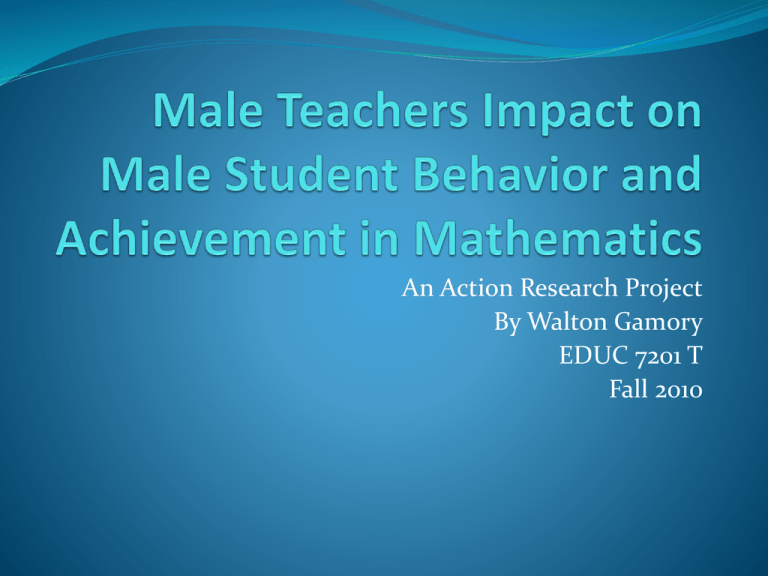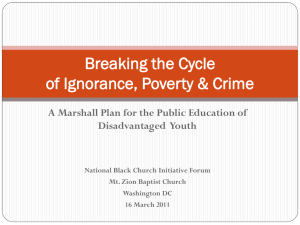Male Teachers Impact on Male Student Behavior and Achievement
advertisement

An Action Research Project By Walton Gamory EDUC 7201 T Fall 2010 Table of Contents Abstract Introduction Statement of the Problem Review of Related Literature Statement of the Hypothesis Method Participants Instruments References Introduction Historically, because teaching has been viewed as woman’s work, and that men who teach especially in the lower grades were lacking in masculinity, this has resulted in the overall reduction of male teachers. The problem is that the percentage of male teachers at the elementary school level has fallen regularly since 1981when it reached an all time high of 18%. This reduction in the overall number of male teachers has had a negative effect on the male student population in regards to student achievement level and behavior. Statement of the Problem Observation at PS X in the New York City elementary school system has revealed a direct correlation between student behavior and lower academic achievement in Mathematics, especially among male students of lower income single parent families. Review of Related Literature Boys learn more from men and girls learn more from women (Marsh, HW, Martin, AJ, & Cheng, JHS,2008). Girls have better educational outcomes when taught by women and boys are better off when taught by men(Dee, 2006). Review of Related Literature PROS: Research Supporting Male as Role Models Male role models can improve the behavior and achievement of boys. Thorton, M, & Bricheno, P. (2007). Bandura, A. (1986). social foundations of thought and action; a social cognitive theory. Prentice-Hall,NJ: Englewood Cliffs. PROS: Research Supporting Male as Role Models Matching teachers and pupils by gender will improve boys’ engagement with school. (TDA 2005) Pupils do better when there’s a match between characteristics of pupils and teachers in terms of gender and ethnicity. Carrington, B., & Shelton, C. (2003). Review of Related Literature CONS: Arguments Against Male as Role Models Policy makers and practitioners positioned the African American male teacher as a one-dimensional “role model.” (Dawson 2001). Matching teachers and children by gender and ethnicity has little impact on attainment. (Ehrenberg, Goldhaber and Brewer 1995) Review of Related Literature CONS: Arguments against Male as Role Models More research is needed on why race and gender influence achievement. This approach could have the unintended consequence of harming student who do not share the minority teacher’s demographic traits. (Dee 2005) Cerve, K. (2010, March 23). Program aims to channel more black males into teaching, particularly at elementary level. Beaufort Gazette,S C-USA, p. 1-4 Statement of the Hypothesis Ninety minutes of weekly instructional intervention by a male teacher will decrease behavioral problems and improve academic achievement in mathematics for fourth and fifth grade male students from lowincome , single female parent households who attend urban public school X. References Ashley, M, & Lee, J. (2003). Women teaching boys stoke-on-trent. Trentham Books. Bricheno, P., & Thorton, M. (2007). Role model,hero or champion? children's views concerning role models. Educational Research, 49(4), 383-396 British Government, Teacher Development Agency. (2005). News release: parent call for more male primary teachers. Retrieved from http://www.tda.gov.uk/about/mediarelations/2005/20051013.aspx. Chudgar, A., & Sankar, V. (2008). The relationship between teacher gender and student achievement: evidence from five Indian states. Compare, 38(5), 627-642. Davis, J. (2010, July 8). African-american males in the classroom: empowering the endangered. Retrieved from http://thefreshxpress.com/2010/07/african american-males-in-the-classroom-empowering-the-endangered Dee, T. (2006). Teachers and the gender gaps in student achievement. Journal of Human Resources, 42(3), 529-554. Dee, T. (2006). The why chromosome. Education Next, 6(4), 68-75. References Ding, C, & Sherman, H. (2006). Teaching effectiveness and student achievement; examining the relationship. Educational Research Quarterly, 29(4), 39-49. Flores, A. (2007). Examining disparities in mathematics education: achievement gap or opportunity gap?. High School Journal, 91(1), 29-42. Gabriel, T. (2010, November 9). Proficiency of black students is found to be far lower than expected. New York Times, p. 2. Harari, O., & Covington, M V. (1981). Reactions to achievement behavior from a teacher and student perspective: a developmental analysis. American Educational Research Journal, 18(1), Retrieved from http://www.jstor.org/stable/1162527 Helm, C. (2007, January/February). Teacher dispositions affecting self-esteem and student performance. The Clearing House, 109-110 Helwig, R., Anderson, L., & Tindal, G. (2001). Influence of elementary student gender on teachers' perceptions of mathematics achievement. The Journal of Educational Research, 95(2), 93-101 References Kafele, B K. (2010, march). Teaching black male students. Principle Leadership,10(7), 76-8. Keller, C. (2001). Effects of teachers' stereotyping on students' stereotyping of mathematics as a male domain. The Journal of Social Psy chology, 141(2), 165-173. Kleinfeld, J., & Sax, L. (2007). Teacher gender. Education Next, 7(1), 6-8. Konstantopoulos, S. (2009) Effects of teachers on minority and disadvantaged students’ achievement in the early grades. The Elementary School Journal, 110(1), 93-113. Kreig, J M. (2005). Student gender and student gender: what is the impact on high stakes test scores. Current Issues in Education, 8(9), 1-8. Learning Theories Knowledgebase (2010, November). Social Learning Theory (Bandura) at Learning-Theories.com. Retrieved November 17th, 2010 from http://www.learning-theories.com/social-learning-theory-bandura.html Marsh, HW, Martin, AJ, & Cheng, JHS. (2008). A multilevel perspective on gender in classroom motivation and climate; potential benefits of male teacher for boys?. Journal of Educational Psychology, 100(1), 78-95. References Martino, W., & Berrill, D. (2003). Boys’, schooling and masculinities: interrogating the right way to educate boys. . Education Review, 55(2), 99-117. Milner, H R, & Howard, T.C. (2004). Black teachers, black students, black communities and brown: perspectives and insights from experts. Journal of Negro Education, 73(3), 285-297. Moses-Snipes, P R., & Snipes, V T. (2005). The call: the importance of research on african american issues in mathematics and science education. Negro Education Review , 56(2/3), 103-105 Powell, C., & Arriola, K. (2003). Relationship between psychosocial factors and academic achievement among african american students. The Journal of Educational Research, 96(3), Retrieved from http://www.jstor.org/stable/27542428 Sanatullova-Allison, E. (2010). Why men become elementary school teachers: insights from elementary teacher education program. Action Teacher Educ, 31(4), 28-40.










